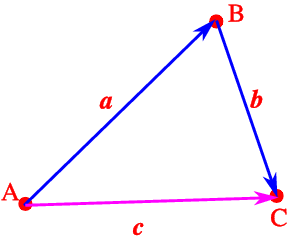
Addition of vectors is achieved by moving the starting point of the second vector to coincide with the endpoint of the first.
Thus, as shown in Fig. 3.6 the displacement vectors are aligned, and we have \overrightarrow{AB} +\overrightarrow{ BC} =\overrightarrow{ AC}. If the displacements represent a, b, and c, respectively we see that a + b = c, or “changing sides” c = a + b. This is called the triangle law of addition. It is used by always drawing displacement vectors that connect in the order of the addition. I.e., in the addition above the endpoint of the representative of a coinides with the start point of the vector b. The sum vector is often called the resultant.
If we investigate both a + b and b + a, as shown in Fig. 3.7, we discover that the displacement vectors form the four sides of a parallelogram (parallelogram law), as well as the fact that the order of addition doesn’t matter (commutativity):
|
\class{boxed}{ a + b = b + a\quad . }
|
If we wish to add several vectors, we repeat the procedure sketched for two vectors, putting all of them end to beginning, \overrightarrow{AB} +\overrightarrow{ BC} +\overrightarrow{ CD} +\overrightarrow{ DE} +\overrightarrow{ EF} =\overrightarrow{ AF}.
For number we know that they have the associative property, (a + b) + c = a + (b + c). Let us investigate graphically whether such a relation holds for vectors. As we see from Fig. 3.9, this can be written in terms of displacement vectors as \overrightarrow{AC} +\overrightarrow{ CD} =\overrightarrow{ AB} +\overrightarrow{ CD}, an obvious truth.
If we add together a set of vectors that returns to the starting point (a closed set of vectors), see Fig. 3.10, \overrightarrow{AB} +\overrightarrow{ BC} +\overrightarrow{ CA} =\overrightarrow{ AA} = 0, we get a zero length vector (the null vector, see below).
If we subtract two vectors, we reverse the one with the minus sign (i.e., reverse the direction of the arrow on that vector) and use the rules for addition, a−b = a + (−b).
In subtraction if b = a then a−a = 0 (zero or null vector). All null vectors are regarded as equal with zero magnitude but no natural direction. 0 + a = a + 0 = a for any vector a.